Power Sector Reform Pays Off
Competitive procurement deploys clean energy capacity efficiently, creates market opportunities for investors, and improves the lives of communities suffering from high energy costs and unreliable service. Read the story
You are viewing:
Information released online before January, 2021.
Note: Content in this archive site is NOT UPDATED, and external links may not function. External links to other Internet sites should not be construed as an endorsement of the views contained therein.
You are entering the 2017-2020 Archive for the
United States Agency for International Development web site.
If you are looking for current information, visit www.usaid.gov.

Competitive procurement deploys clean energy capacity efficiently, creates market opportunities for investors, and improves the lives of communities suffering from high energy costs and unreliable service. Read the story
When utilized strategically, reverse auctions can facilitate competitive renewable energy price setting, lower costs, expand access to affordable and sustainable energy, and increase transparency of energy procurement.
An auction is a competitive process for policymakers to procure electricity generated by renewable energy. Policymakers can hold auctions regardless of market maturity and institutional capacities and can choose different entities to conduct auctions. An auctioneer can be an energy regulator, electricity market operator, or dedicated agency. The auctioneer issues a tender with clear rules in an online or other public platform, which ensures a transparent and competitive procurement process.
By 2019, 109 countries around the world had held auctions, up from 98 in 2018. Countries have chosen different entities as auctioneers. In the case of Germany and Senegal, the auctioneer was the energy regulator. In Brazil, Colombia, and Mexico, the auctioneer was the electricity market operator. In Morocco and South Africa, the auctioneer was a dedicated agency.
The three most common price-setting methods for procuring electricity from renewable energy are feed-in tariffs, negotiated tenders, and auctions.
Unlike negotiated tenders and feed-in tariffs, auctions have the potential to provide price discovery, reduce windfall profits for power producers, and lower electricity prices for cash-strapped utilities and consumers by forcing companies to compete against one another on price. In addition, auctions allow greater volume control and more market-reflective, competitive pricing than feed-in tariffs. They also scale more easily and enable faster project execution compared with negotiated tenders.
For countries with limited market maturity and institutional capacities, it is important to design simple auctions. However, more complex auctions can better react to different policy preferences and market conditions.
Before designing an auction, policymakers should define policy objectives to be achieved with the auction. Two of the most common policy goals of auctions are allocating available funding efficiently and achieving renewable energy generation targets through the timely implementation of projects. Other policy goals include grid and system integration of awarded projects and positive socioeconomic effects at the local level.
Auction designers should also know the market, project development cycles, and available institutional capacities to adequately distribute risk between renewable energy producers and the public.
Renewable energy auctions allow policymakers to procure clean energy at competitive prices by assisting in price discovery and reducing windfall profits for power producers. Read the fact sheet
The Policymaker’s Guide introduces key auction design concepts for energy ministries, utilities, regulators, and other stakeholders who make decisions on the design of renewable energy auctions. Read the guide
Following 800 renewable energy auctions in 61 countries, it is now possible to identify some common stages of design and implementation that auction programs move through as they mature. Read the fact sheet
Comment
Make a general inquiry or suggest an improvement.